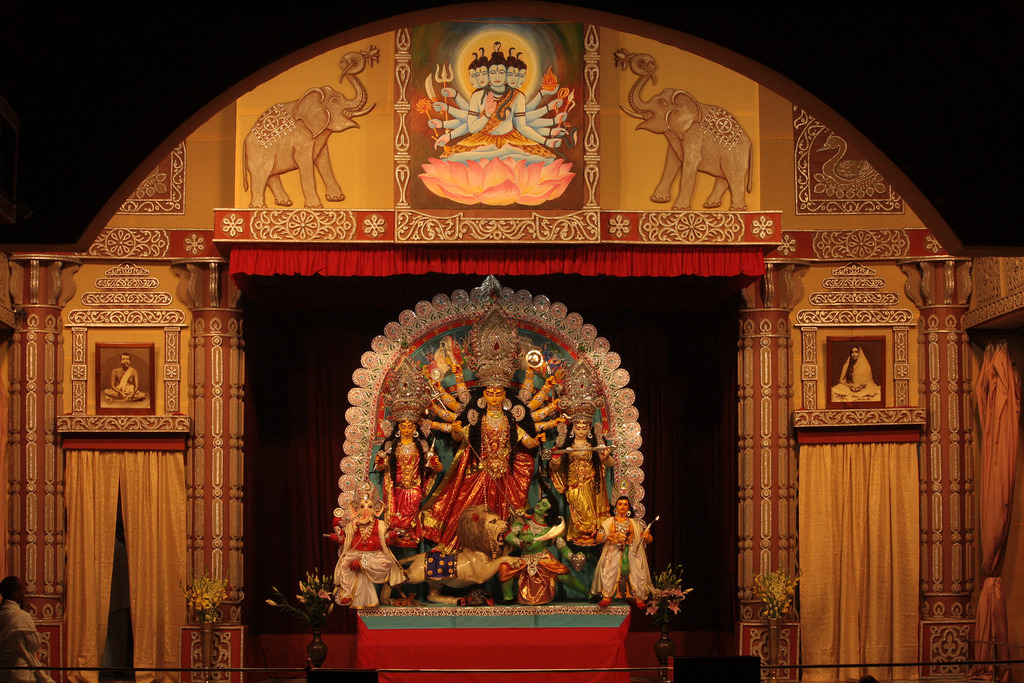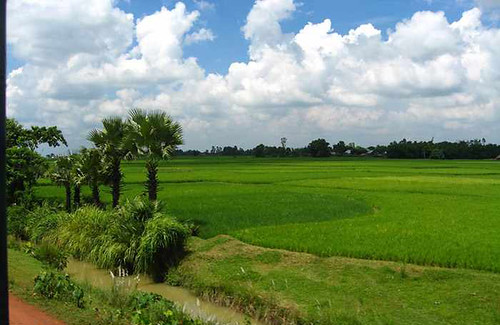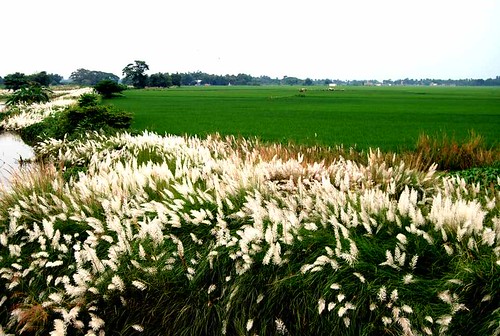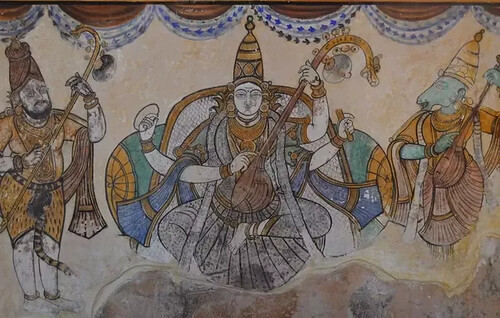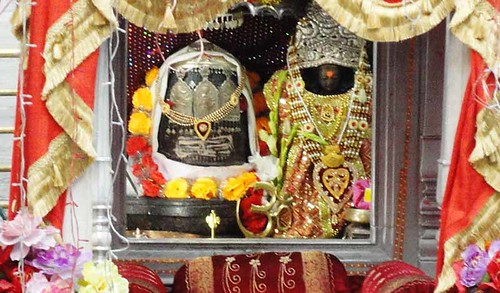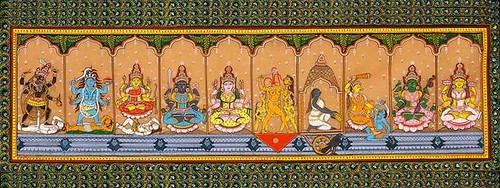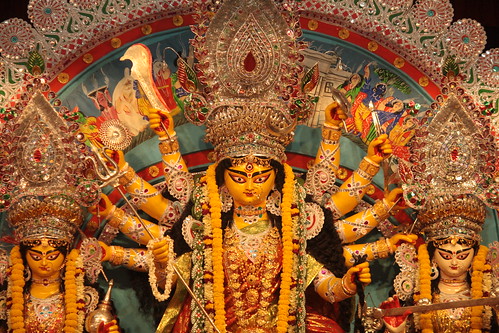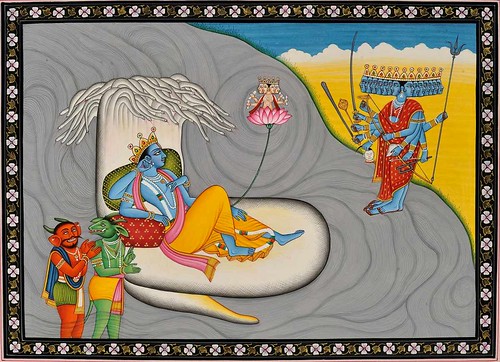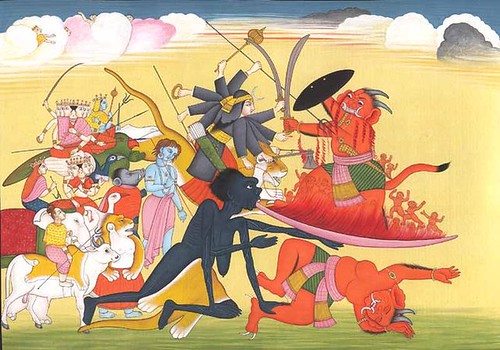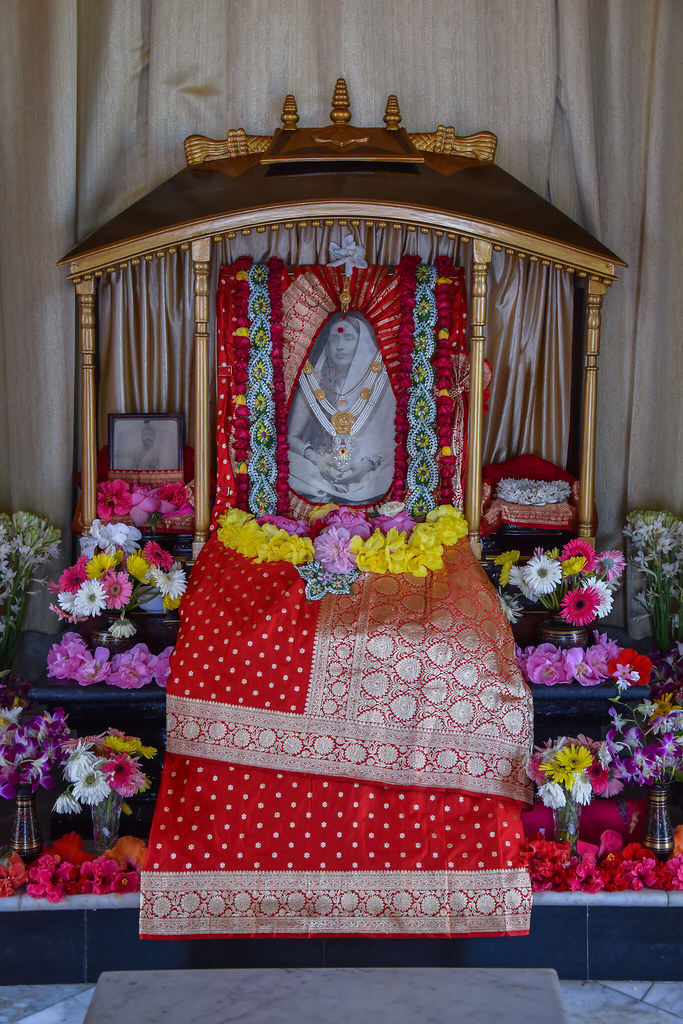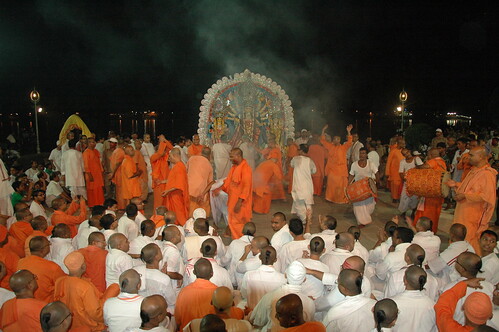DURGA PUJA:
GENERAL INFORMATION
The Glory of Autumn
Autumn (Sharat) is regarded as one of the best seasons in India. The sun is on his southward journey and, as his blazing rays begin to slant, the subcontinent feels freedom from the oppressive heat of summer months. The monsoon has infused new life into trees, shrubs, creepers, herbs, grass, moss and lichen; and Gaia, the Earth Goddess, shows herself off in her richly embroidered green apparel of lush vegetation everywhere.
In the villages there is a look of plentitude and peace. The granaries are full with freshly garnered grain, the fields offer large open spaces with cattle grazing here and there, and along the borders of fields you can see rows of white and light pink kashphool(flowers of a kind of tall grass) tassels waving triumphantly in the breeze. Overhead, the sky is deep blue with an occasional white cloud sailing across lazily to an unknown destination. A kind of mystic silence pervades the air, broken only by the laughter of children playing here and there.
It is as if Nature has prepared herself for the advent of the Divine Mother. Indeed, which other season can be a better one to welcome the Divine Mother than autumn? And Durga Puja is about the advent of the Divine Mother.
Worship of the Divine Mother
Worship of the Divine Mother is one of the oldest forms of worship known to humanity. In prehistoric times, God was worshipped as the Divine Mother all over the world. Evidences for Mother Worship have been recovered in different places in Europe, the Americas, Africa and Asia. But it is only in India that Mother worship went beyond the framework of a cult and became a full-fledged living religion supported by an advanced theology, scriptures, rites, customs and festivals which are followed by millions of people even in modern times. And in Bengal, worship of God as Mother attained the highest form of a cultural refinement and ritual sophistication, and became the dominant faith and practice of the people.
Sri Ramakrishna used to say: ”To look upon God as Mother is the purest and the highest form of Sadhana” (Matribhav shuddha bhav, sadhanar shesh katha). Why did he say that? Because Mother’s love is the most unselfish and unconditional form of human love. For a child, mother is all sufficient: apart from giving birth, she provides everything that the child needs – nourishment, protection, warmth, comfort, training, education. To look upon God as Mother is to make God all-sufficient in one’s life. It is a very natural, intimate and purest form of relationship.
Mother Worship in India
Worship of God as Mother has prevailed in India from prehistoric times. It was perhaps in vogue in Mohenjodaro-Harappa civilization. In the Rig Veda, there is a wonderful hymn known as Devi-Suktam (which is chanted during Durga Puja days) in which the Divine Mother declares that She moves with the Rudras, Vasus, Adityas, and all other gods, that She is the power of all gods, that She is the Queen of the world, and so on.
It is, however, in the Devi-Mahatmya, popularly known as the Chandi, that worship of the Divine Mother assumes an independent, supreme status. Although Chandi forms a part of Markandeya Purana, it is treated as an independent scripture. For devotees of the Divine Mother, especially in Bengal, Kerala and some parts of Tamil Nadu, Chandi is regarded as the most sacred and valued scripture. It was composed sometime between the 6th and 9th centuries AD.
Another authoritative book on Shakti worship is Devi-Bhagavatam. Between the 6th and 16th centuries a class of Shakta scriptures known as the Tantras (believed to be 63 in all) came into existence. The Tantras became popular in three areas, namely Bengal, Kerala and Kashmir, which form the three angles of a geographical triangle.
Worship of the Divine Mother is prevalent all over India – from Kanyakumari (famous for its Kanyakumari temple) to Kashmir (Kshirbhavani temple) and from Rajasthan (Amba temple) to Kolkata (Kalighat temple). In fact, there is hardly any large area in India which does not have a Devi temple. Great heroes of the past worshipped the Divine Mother. Sri Rama is said to have worshipped Durga before killing Ravana. Shivaji, the great Maratha king, was a votary of Bhavani. Guru Govind Singh, the tenth Guru of the Sikhs, is also said to have been a worshipper of Mother Durga.
Different Forms of Divine Mother
Although the Divine Mother is only one, Her manifestations are many. During the early centuries of the Christian Era, the Divine Mother was worshipped as an independent and Supreme Goddess. She was mostly pictured as riding a lion (Simha-vahini). This is the image of Durga we find in the Chandi where she appears as Chamundeshvari and Mahishasura-mardini.
In later centuries, the Divine Mother came to be regarded as the spouse of God Shiva. Here again, there were two schools. In one school, the Divine Mother and Shiva are regarded as equal in power. This school, known as ”Samya”, is the more common one, especially in South India. In the other school, known as ”Kaula”, the Divine Mother as Kali is regarded as the dynamic principle, and Shiva as the passive principle. This school is most prevalent in Bengal, and also in Kashmir and Kerala.
The Divine Mother is regarded as having ”Ten Great Wisdom Forms” (Dasha-mahavidya). These ten Goddesses are:
- Kali
- Tara
- Tripura Sundari
- Bhuvaneshwari
- Bhairavi
- Chhinnamasta
- Dhumavati
- Bagalamukhi
- Matangi (Saraswati)
- Kamala (Lakshmi)
Navaratri and Durga Puja
The nine days from the first day after the new moon (known as Mahalaya) in the Indian month of Ashwin to the 9th day constitute the festival of Navaratri which is observed all over India. During this period, the Divine Mother is worshipped in some form or other. The majority of Hindus who cannot conduct such worship at home visit Mother’s temple in their locality after taking bath and putting on new clothes. The tenth day is known as Dassera. In the northern parts of India, on this day the life of Rama (known as Ramlila) is enacted in public. In many parts of India, on this day weapons, implements, instruments, etc are worshipped. [In Bengal, this worship of tools and implements takes place on another special day known as Vishwakarma Puja.]
It is during this period of Navaratri that Durga Puja is celebrated in Bengal. The celebration of Durga Puja is a unique feature of the socio-religious culture of Bengal. In no other part of India does the worship of Durga affect the lives of the people so deeply as it does in Bengal. Festivities begin from Mahalaya and go on for nearly a month. During this period, people put on new clothes, worship the Divine Mother at any of the beautiful Durga pandals put up in different parts of the city or town, and enjoy feasts.
The most striking aspect of Durga Puja is the image of the Divine Mother as Mahishasura-mardini. Here the Divine Mother is seen as having ten arms, each wielding a weapon. [Hence She is described as Dasha-prahara-dharini.] Once the image is consecrated, and the Deity is invoked in it, it undergoes a transfiguration. It is no longer a clay image but the living Goddess, radiating power, knowledge, love and joy, the benign Mother of the Universe who has come to bless Her children and to assure them of Her love, help and protection.
Another prominent feature of Durga Puja celebration is the gorgeous Pandal or Durga dalan in which the worship is conducted. Durga Puja is meant for public worship, in which a large number of people participate. Its rituals and paraphernalia are quite expensive. Formerly only kings and aristocratic families could afford to celebrate such public worship. But in modern times Durga Puja is done through organized community effort. People of a locality or street form a celebration committee, take collections and put up the imposing pandal.
Who first started this kind of public celebration of Durga Puja? The generally accepted view is that it was Kamsa-narayan, king of Tahirpur in Rajshahi District (now in Bangladesh), who first started the present style of public celebration of Durga Puja around the year 1600.
Commingling of Legends
What is the mythological basis of Durga Puja? Several mythological legends have commingled to form the basis of Durga Puja. These are mentioned below:
- Before fighting Ravana, Sri Ramachandra was advised by Narada to propitiate Devi Durga. According to Hindu mythology, during the six months of the sun’s southward journey the gods remain asleep. (They remain awake during the six months when the sun moves northward.) So Rama had to awaken the Goddess first. This is why the first ritual in Durga Puja is the awakening (bodhan) of Durga. This legend is found in the Ramayana in Bengali written by Krittivas. In some other Puranas it is mentioned that, when Rama wanted to propitiate Devi, it was Brahma who did the awakening. The present-day Durga Puja is, thus, a commemoration of the first Durga Puja performed by Sri Rama.
- The second legend is about the coming of Devi Uma from Her abode in Kailash to the home of her parents – Himavat and Menaka. She comes riding a lion. In the Vedas, Uma is first mentioned in the Kena Upanishad where She is described as Uma Haimavati. It is a popular belief in Bengal that Uma comes and stays with the people for three days. A whole set of songs, known as Agamani, describing the homecoming of Uma has come into existence. These songs are sung during the days preceding Durga Puja. These songs serve to spiritualize Hindu mother’s love and concern for their married daughters.
- The third legend is about Sati Devi. Although neither Sati nor Uma is mentioned in the Chandi, in the mool-mantra used in Durga Puja, Sri Durga is addressed as Daksha-yajna-vinashini, ”The Destroyer of Daksha’s sacrifice.” Daksha was one of the Prajapatis or Creators of the Universe. He had eight daughters, of whom the eldest was Sati. Against her father’s wish, Sati married the great God Shiva who was an ascetic wearing matted hair and leading an unconventional life on Mount Kailash. After some years, the roving Rishi Narada reached Kailash and gave the news that Daksha was going to conduct a big sacrifice to which all gods and goddesses were invited, except Sati and Shiva. Although uninvited, Sati went to see her father. But Daksha spoke insultingly of Shiva and, unable to bear the insult, Sati fell down dead. Shiva was naturally enraged; and his anger burnt to ashes Daksha and his sacrifice, and then Shiva began a dance of destruction. But the gods intervened, and Shiva finally returned to His meditation in Mount Kailash. Sati was reborn as Parvati who, after years of intense tapas, got Shiva as Her husband once again. The mool-mantra, Daksha-yajna-vinashinyai, refers to the destruction of Daksha’s sacrifice mentioned above. It is, however, quite obvious that this great Mantra has some deeper mystic, esoteric meaning far beyond the mythological significance.
- The most important legend which is central to Durga Puja is about Durga, and forms the theme of Chandi. The word Durga literally means one who ”protects like a fort” or one who ”destroys the evil consequences” of our actions (durgati-nashini). In the Chandi, Durga is mostly referred to simply as Devi, the Goddess, and occasionally as Ambika. She is an independent, supreme Goddess, not the consort of any male God. As already mentioned, the Chandi is one of the oldest scriptures on Mother Worship. It was obviously composed before the sectarian divisions of Shaivism, Vaishnavism and Shaktism entered Hinduism. Hence Devi is referred to in this book as the Power of Vishnu and also addressed as Narayani repeatedly.
Durga in Chandi
The Chandi is divided into three parts. In the first part Devi appears as Mahamaya which is described as yoga-nidra of Vishnu. That is to say, Mahamaya is the power of Tamas which makes people lethargic, indolent and sleepy. Under the influence of this cosmic delusive Power, Lord Vishnu went to sleep. At that time two demons by name Madhu and Kaitabh came out the ears of Vishnu and attacked Brahma the Creator God. Brahma then praised the Divine Mother as Mahamaya or Yoga-nidra. Pleased with the petition, she withdrew herself from Vishnu’s body. Vishnu now woke up and killed Madhu and Kaitabh.
In the second part Devi appears as Mahishasura-mardini and is also called Chandika. The story goes that when a powerful demon by name Mahishasura was the king of the Asuras (demons), they attacked the Devas (gods) and vanquished them. The defeated gods went to Shiva and Vishnu and complained about the atrocities of Mahishasura. Hearing this, Vishnu, Shiva and other presiding Deities became angry. The rays of their anger combined to form a supremely powerful and dazzlingly bright female Being – the Devi known also as Chandika and Ambika. Seeing the dazzling brightness of the Devi, Mahishasura first sent his army to attack Her. But the Divine Mother exterminated them all. Then Mahishasura, who had the form of a buffalo, himself attacked Her. Devi at once jumped upon his body, pressed his neck with her foot, struck his chest with her spear, and finally cut off his head. The gods being extremely relieved and pleased, praised the Devi, and their praise takes up the rest of the second part of Chandi.
In the third part of the book, Devi appears first as Parvati and then, out of her form, there arises another form known as Kalika. But she continues to be referred to as Ambika. The third part narrates another valorous act of the Divine Mother. Once upon a time two brothers, Shumbha and Nishumbha became lords of the three worlds, and the gods lost everything. Coming to know of the beauty of Kalika, they sent word to her asking her to come to them. When she spurned their order, they at first sent two demons, Chanda and Munda, to capture her. Seeing them, Ambika became angry and out of that anger there issued forth a terrible form known as Kali who fought with the demons. Finally Kali cut off the heads of Chanda and Munda. She thus came to be called Chamunda. Now Shumbha and Nishumbha themselves rode in their chariots and attacked Ambika and Kali. After a protracted battle Ambika herself destroyed Shumbha and Nishumbha.
Significance of Chandi
The image of Durga as Mahishasuramardini epitomizes the Chandi. To understand the significance of the image we have to understand the significance of the Chandi.
The gory scene depicted by the image of Durga, and the blood-curdling descriptions of a warrior Goddess exterminating hordes of evil doers drenching the earth with blood, may be enigmatic and repulsive to some people, especially to those who are outside the Shakta tradition of Hinduism. A mature and realistic understanding of the Divine in the context of the real situations in human life and society is necessary to understand the true significance of Chandi. The basic significance of Chandi may be briefly stated as follows.
- The main purpose of Chandi is to glorify Shakti. Shakti is the dynamic aspect of the ultimate Reality known as Brahman. Shakti is generally regarded as the feminine principle. The feminine principle has two aspects: a lower, seductive aspect, and a higher, maternal aspect. It is the higher maternal aspect that is glorified in the Chandi, and in the Shakta tradition in general. Sri Ramakrishna used to say: Jini Brahma tini Shakti, tini i Ma ”He who is Brahman is Shakti, and He himself is the Mother of the Universe”
A mother has three main functions: to give birth, to nourish, to care and protect. It is the third aspect that is highlighted in the Chandi. God is not a disinterested spectator of the drama of human life. She is an active participant. She protects people from dangers. Think of the cosmic figure of a Divine Mother towering over millions of people guarding them from dangers, punishing evil doers. Well, you can see this image of the Cosmic Mother in the Chandi.
- The second purpose of the Chandi is to depict the reality of evil. Vice, wickedness, cruelty, injustice, suffering – all these are as much real as virtue, love, compassion, cooperation etc which humanity has idealized and dreamed about from time immemorial. Dharma and Adharma, virtue and vice, are two inseparable aspects of reality, and we have to accept both.
We generally tend to associate Godhead only with love and compassion. We forget that Godhead has also an aspect of power, terror and destruction. It was this destructive aspect of Godhead that Sri Krishna showed Arjuna through the Vishwarupa Darshana revelation. What we find in the Chandi is the same terrible aspect, but associated with the Eternal Feminine.
Mahishasura, Shumbha, Nishumbha and other characters portrayed in the Chandi are of course mythological, but this does not make them irrelevant in the present-day world. Do we not find similar, or even worse, types of people in modern times? Political leaders who commit mass genocide, terrorists who bomb crowded trains, buses and market places, serial murders, rapists et cetra, about whom we read in newspapers – are these people in any way better than the demons described in the Chandi? As a matter of fact, Chandi assumes greater reality and relevance in the contemporary world than at any other time before.
Chandi is not a book of romance. Nor does it promise a utopian world. On the contrary, it wakes us up from our futile dreams and situates us right in the midst of the terrible realities of the present-day world which we very often fail to face.
- The third message of the Chandi is the empowerment of women. In recent years there is a lot of talk about empowerment of women, especially in rural and tribal areas in India. The Chandi shows to what heights this empowerment can be raised. In all countries in all times, women have been indoctrinated from childhood to believe that they are weak, helpless and totally dependent on men. The Chandi shows how much power women can wield, how they can work independently, and face boldly even the worst challenges of life without unduly depending on men.
- Lastly, Chandi delivers a message of hope, the assurance of divine help and succour. In spite of all the terrible happenings described in the book, there is absolutely no pessimistic tone or note of despair in the Chandi. Let troubles and difficulties come, let even dire calamities occur; we have nothing to fear, for there is a God, a Mother, who protects us from all dangers or gives us the inner strength to face them. In modern times the Divine Mother, born as Sri Sarada Devi, has given us this assurance: ”Always remember, there is somebody behind you … Place your burden upon me and remain unperturbed.” This is also the last message of the Chandi.
DURGA PUJA AT BELUR MATH
Durga Puja was first celebrated at Belur Math in 1901. Since then Durga Puja has been celebrated at Belur Math year after year, although for a few years after the first celebration in 1901, Pratima worship was not done. (In this connection it should be mentioned that Durga Puja was conducted on a small scale, without the image, by the disciples of Sri Ramakrishna during the early years of Ramakrishna Math at Baranagar.) It was Swami Vivekananda himself who started the first Durga Puja with the image at Belur Math. As a rule, Hindu Sannyasins do not conduct this kind of ritualistic worship. Why then did Swamiji start the new tradition?
One reason was to gain the acceptance of the local community for the new way of life that Swamiji and his monastic brothers were leading. The Hindu society in Calcutta had not fully accepted Swamiji’s going to the West, and the rather unconventional ways of life at Belur Math which included disregard for caste rules and mixing with Western people. As a matter of fact, the celebration of Durga Puja helped to remove much of the misunderstanding and misgivings about the new monastic institution among the local people.
Another reason was Swamiji wanted to institutionalize respect for divinity of motherhood and sanctity of womanhood. Swamiji saw that one of the main reasons for the advancement of Western people was the elevation of women in the West, and one of the main reasons for the backwardness of India was the neglect of women in this country. Worship of the Divine Mother, especially the Kumari Puja, would create the awareness of the potential divinity of women and a respectful attitude towards them.
A third reason was supernatural. A few days before Durga Puja in 1901, Swamiji had a vision of Durga Puja being done at Belur Math. More or less at that time, Swami Brahmanandaji saw in a vision Mother Durga coming across the Ganga from Dakshineshwar to Belur Math. Swamiji asked Raja Maharaj to make preparations for Durga Puja immediately, although only a few days were left to begin the Puja.
The main problem was to get a clay image for worship. Enquiries at Kamartuli (the street in Kolkata where artisans make clay images) revealed that there was a single beautiful image of Durga in a shop. The person who had ordered it had not turned up, and so the artisan agreed to sell it to the monks.
Apart from the image, a lot of other things had to be collected for the elaborate ritualistic worship. Under able direction of Swami Brahmanandaji everything was done well at short notice.
The first Durga Puja at Belur Math was conducted in a huge Pendal (decorative shed) on the open ground to the north of the old shrine. The invocatory worship on Shashthi (the 6th day of the lunar month) was on 18 October 1901. The Pujari was Brahmachari Krishnalal and the Tantradharak was Isvar Chandra Chakravarty, the father of Shashi Maharaj. Sitting under the Bel tree (which now stands in front of his temple) Swamiji sang Agamani songs welcoming the Divine Mother.
The householder disciples of Sri Ramakrishna and orthodox Brahmins of nearby area had been specially invited, and thousands of people, irrespective of the distinctions of caste or religion, attended the three-day festival. On the night of Navami Swamiji sang many songs in praise of Divine Mother, some of which used to be sung by Sri Ramakrishna.
Holy Mother and Durga Puja
When Swamiji decided to celebrate Durga Puja at Belur Math, one of the first things he did was to seek the approval of Holy Mother Sarada Devi who was then staying at Baghbazar in Kolkata. Swami Premananda went to Mother, and Mother whole-heartedly approved the proposal. On Shashthi day She came with other women devotees and stayed at Nilambar Babu’s garden house nearby. Mother attended the awakening ceremony that day and attended the Puja on all the three subsequent days.
Since Sannyasins cannot undertake this kind of ritualistic worship, Swamiji decreed that the Puja should be done in the name of Holy Mother. This became a tradition which continues to this day. Swamiji looked upon Sri Sarada Devi as the divine counterpart of Sri Ramakrishna, born for the awakening of womankind in the modern world. In a letter to Swami Shivananda written in 1894 from America, Swamiji had given expression to his conviction about the Divinity of Holy Mother as follows: ”Brother, I shall show how to worship the living Durga (Jivanta Durga), and then only shall I be worthy of my name. I shall be relieved when you have purchased a plot of land and established there the living Durga, the Mother (i.e. Sri Sarada Devi).” The presence of Holy Mother, the Living Durga, during the Puja must have given boundless joy and satisfaction to Swamiji and the other disciples of Sri Ramakrishna.
Holy Mother attended the Durga Puja at Belur Math in 1912 and in 1916 and perhaps in some other years also. Each time Mother stayed for a few days and blessed Her monastic and lay children.
Agamani
As already mentioned elsewhere, several mythological legends underlie Durga Puja festival. One of these is the legend that every year during the Navaratri, Goddess Uma, who is identified with Parvati the divine consort of Shiva, comes to the home of her parents – Himavat and Menaka. In Bengal this legend has been universalized into the belief that the Divine Mother visits the homes of all her children during the three days of Durga Puja. Agamani songs are songs which vividly depict the maternal love and deep concern of Menaka for her divine daughter. They are sung to welcome Mother Uma into homes. They also reflect parents’ love for their married daughters.
Swami Vivekananda was fond of Agamani songs because of the tender feelings expressed in them. On the Shashthi of the first Durga Puja at Belur Math, Swamiji sang Agamani songs such as, Giri Ganesh amar shubhakari etc. The tradition of singing Agamani songs continues in Belur Math. Every year from the first day (pratipada) after Mahalaya to the sixth day (Shashthi) Sadhus and Brahmacharins gather at the main temple of Sri Ramakrishna at dawn and sing Agamani songs in chorus. [At night, after Arati, they conduct Kalikirtan.]
Chandipath
During the nine days of Navaratri the book Chandi is recited everyday morning. This recital is done along with worship of the Goddess Chandi. In Belur Math this is done during the first five days at a corner of Natamandir and from the 6th at a corner of Durga Mandap itself.
Shashthi : the 6th day
This is a very important day when ritual preparations are made to begin the Durga Puja proper. These preparations are mainly three: Kalparambha, Bodhan, Adhivas and Amantran.
Kalparambha : This ritual is done early in the morning. It is mainly an act of making the samkalpa or ”sacramental intention”, the firm determination to conduct the Puja properly during the three days. The ritual consists of installing the ghata, water-filled copper pot, at a corner of Durga mandap and offering worship to Durga and Chandi.
Bodhan: This rite is performed at the Sandhya or dusk. The word ‘Bodhan’ literally means ‘awakening’. As already mentioned elsewhere, the Hindu mythology holds that all gods and goddesses go to sleep for six months during the southward journey of the Sun. Autumn (Sharat), during which Durga Puja is done, falls in the middle of this period. Hence it is necessary to first of all awaken the deity Durga. We have already mentioned that the awakening of Durga was first done by Sri Ramachandra who wanted to propitiate the Goddess before fighting Ravana.
The ritual of Bodhan consists in installing a water-filled copper vessel at the base of the Bel (Bilva) tree (or, as is now done at Belur Math, keeping a branch of the Bel tree in the pot) and praying to the Divine Mother to awaken.
Adhivas and Amantran : These rites follow Bodhan. Adhivas means ”invocation”. Through Bodhan the Devi has awakened: now the awakened Devi has to be invoked in the Bel tree or branch of the tree. Adhivas is also a ritual of sanctification. The actual ritual consists of the following main steps.
- Devi Durga and the Bel tree are first worshipped
- Twenty-six sacramental things (mangalik dravya) are sanctified by touching Devi Durga and the Bel tree with them.
- To ward off evil effects, a red coloured thread is tied around the altar where Puja is done.
The above ritual is followed by Amantran which literally means ”invitation”. Through this rite the Devi is invited or entreated to accept the Puja the next day (Saptami).
After this, Devi is worshipped with five items and Arati is done to Her.
Saptami Puja
The important point to note here is that a living medium is necessary to invoke the indwelling of a deity. It is through a living medium that Divinity manifests itself. On the sixth day Divinity was invoked in the Bel tree or a branch of it. On the seventh day the Deity is invoked in a group of nine plants known as Navapatrika. The nine plants, which include a branch of Bel tree also, are bundled together, given a ceremonial bath, covered with an orange coloured cloth and installed on a wooden seat on the right side of the image of Durga. This is followed by Mahasnan (great bath) on a mirror, using various materials. After this, consecration and divinization of the image, known as pranapratishtha, takes place. This is followed by elaborate worship of the Devi with sixteen items (shodashopacharapuja). The other deities, attendants and other objects associated with Devi are then worshipped. The Seventh Day’s Puja is concluded with bhog (food offering) and Arati to Devi.
Ashtami Puja
As on Saptami, on Ashtami also, Mahasnan and Shodashopacharapuja are done. In addition, nine small pots with flags of different colours attached are installed and the Nine Shaktis are invoked in them and worshipped. After this sixty-four yoginis are worshipped. Then one crore yoginis are worshipped. This is followed by worship of Nava Durga (nine aspects of Durga) and Goddesses Jayanti, Mangala, Kali, Bhadrakali, Kapalani, Durga, Shiva, Kshama, Dhatri, Svaha and Svadha. Ashtami Puja is concluded with Bhog and Arati.
Kumari Puja : Worship of a young girl, treating her as Devi, is also a part of Ashtami Puja. Sri Ramakrishna has said that the Divine Mother manifests herself more in a pure-hearted girl and that is why Kumari Puja is done. He used to bow down before little girls looking upon them as manifestations of the Divine Mother. When Durga Puja was done at Belur Math for the first time, Swami Vivekananda worshipped several Kumaris. Now only one Kumari is worshipped. The same kinds of offerings made to the Devi are given to the Kumari also, and finally Arati is performed. Even senior monks offer flowers at her feet.
Sandhi Puja : The last 24 minutes of Ashtami and the first 24 minutes of Navami (a total of 48 minutes between the two lunar days) constitute the Sandhi or ”Sacred Juncture”. It is considered to be a most auspicious time. At this time Durga is worshipped as Chamunda (that is, Kali who killed the demon Chanda and Munda). This Puja is considered to be the highest point in the whole Durga Puja and the most important ritual.
It is customary to perform bali or animal sacrifice at this sacred juncture. When the first Durga Puja was celebrated at Belur Math in 1901, Swami Vivekananda wanted to have bali done. But Holy Mother prohibited it and, in obedience to Holy Mother’s injunction, animal sacrifice is never done at Belur Math. Instead, a banana is ‘sacrificed’ as a symbolic bali.
Navami Puja
As in Ashtami, during Navami also Mahasnan and Shodashopacharapuja are offered to Devi. In addition, bali and Homa are performed. In Belur Math for bali white pumpkin and sugarcane are offered. The Homa (fire sacrifice) is a combination of Vedic and Tantric traditions.
Dashami Puja
In the morning a brief Puja, Shital bhog (cooling food offering) and Arati are first done. Then the Pujari and Tantradharak circumambulate the altar and perform the visarjan ritual. In this ritual the Devi, who had been invoked in the Navapatrika and consecrated Image, is entreated to return to Her celestial abode. The Divine Mother, however, dwells for ever in the hearts of devotees.
In the evening the Image of Durga along with Navapatrika is taken in procession to the river bank and immersed in the river. The water taken from the spot, known as Shanti Jal is sprinkled on the devotees who embrace one another as an expression of their solidarity as children of the same Divine Mother. And thus the holy Durga Puja comes to an end leaving joyous memories in the souls of people.

